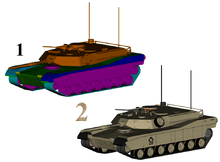
Waterworld
Waterworld is a 1995 American post-apocalyptic science fiction action film directed by Kevin Reynolds and co-written by Peter Rader and David Twohy. It was based on Rader's original 1986 screenplay and stars Kevin Costner, who also produced it with Charles Gordon and John Davis. It was distributed by Universal Pictures.
The setting of the film is in the distant future. Although no exact date was given in the film itself, it has been suggested that it takes place in 2500. The polar ice caps have completely melted, and the sea level has risen over 7,600 m (25,000 feet), covering nearly all the land. The film illustrates this with an unusual variation on the Universal logo, which begins with the usual image of Earth, but shows the planet's water levels gradually rising and the polar ice caps melting until nearly all the land is submerged. The plot of the film centers on an otherwise nameless antihero, "The Mariner", a drifter who sails the Earth in his trimaran.
The most expensive film ever made at the time, Waterworld was released to mixed reviews, praising the futuristic landscape and premise but criticizing the characterization and acting performances. The film also was unable to recoup its massive budget at the box office; however, the production did later break even due to video and other post-cinema sales. The film's release was accompanied by a tie-in novel, video game, and three themed attractions at Universal Studios Hollywood, Universal Studios Singapore, and Universal Studios Japan called Waterworld: A Live Sea War Spectacular, which are all still running as of 2016.
Waterworld (pinball)
Waterworld is a Gottlieb pinball machine released in October 1995. It is based on the film of the same name.
External links
Water World
Water World or Waterworld can mean:
- Waterworld (video game), trio of video games based on the film
- Waterworld (pinball), a pinball machine based on the film
- Waterworld: A Live Sea War Spectacular, show featured at many Universal Studios parks around the world based on the 1995 film
Texture
Texture may refer to:
Science and technology
- Texture (roads), road surface characteristics with waves shorter than road roughness
Arts
Music
See also

Texture (painting)
Texture in painting is the look and feel of the canvas. It is based on the paint, and its application, or the addition of materials such as ribbon, metal, wood, lace, leather and sand. The concept of 'painterliness' also has bearing on texture. The texture stimulates two different senses; sight and touch. There are four types of texture in art: actual texture, simulated texture, abstract texture, and invented texture.
Actual texture
This is a combination of how the painting looks, and how it feels to the touch. It is associated both with the heavy buildup of paint, such as an impasto effect, or the addition of materials.
Simulated texture
Creating the visual effect of texture without actually adding texture. For instance, a texture created to look like something other than paint on a flat surface. An example is Cataract 3, painted in 1967 by Bridget Riley, which creates the illusion of ripples in the paper through the repetition of lines.
Implied texture
Texture that does not directly represent the object it is connected with but the concept of the object is translated in textural patterns.

Texture mapping
Texture mapping is a method for adding detail, surface texture (a bitmap or raster image), or color to a computer-generated graphic or 3D model. Its application to 3D graphics was pioneered by Edwin Catmull in 1974.
Originally a method that simply wrapped and mapped pixels from a texture to a 3D surface - now more technically called diffuse mapping to distinguish it from more complex mappings - in recent decades the advent of multi-pass rendering and complex mapping such as height mapping, bump mapping, normal mapping, displacement mapping, reflection mapping, mipmaps, occlusion mapping, and many other complex variations on the technique have made it possible to simulate near-photorealism in real time, by vastly reducing the number of polygons and lighting calculations needed to construct a realistic and functional 3D scene.
Podcasts:

